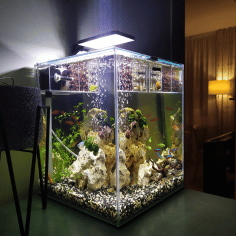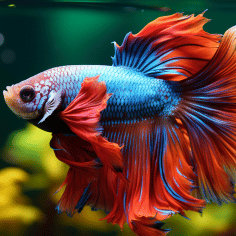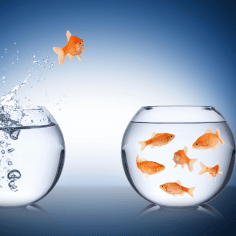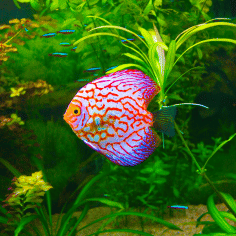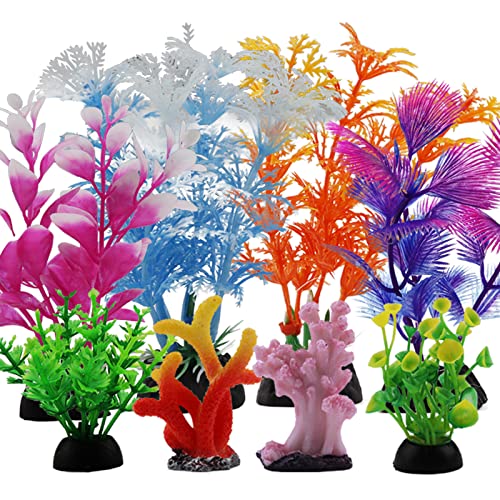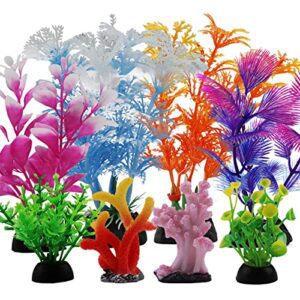Cichlid Fish Tank Setup Ideas – Setting up a cichlid fish tank can be an exciting venture, blending aquascaping creativity with the specific needs of these colorful fish. Cichlids thrive in environments that replicate their natural lake or river habitats, which are typically rich in hiding spots and territorial landmarks.
To achieve this, use a fine sand substrate for digging and include plenty of rocks to form caves and crevices. Ensure the tank is spacious enough to accommodate your cichlids, as they can be territorial and require room to establish their own space. Proper filtration is critical to maintain water quality, and the temperature should be consistent with the species-specific requirements. Lighting should not only enhance the beauty of your tank but also support any live plants you choose to include. Remember to cycle the tank before introducing your fish to ensure a healthy start for your aquatic community.
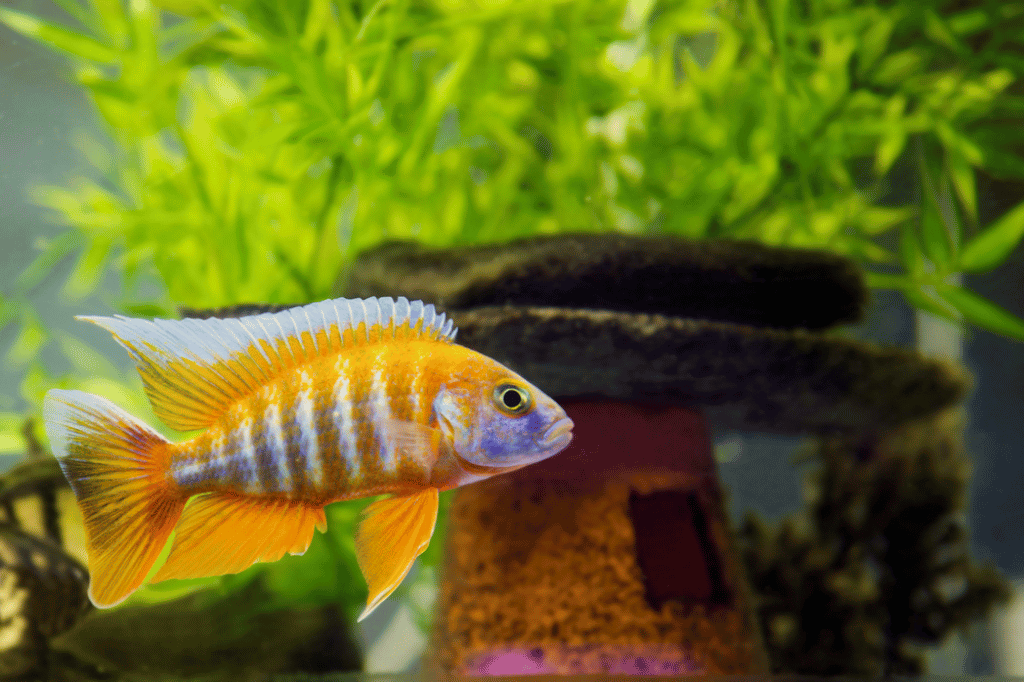
Cichlid Fish Tank Setup Ideas: Vibrant Aquascapes Unveiled By Insiderfish.com
Introduction To Cichlid Fish
Welcome to the vibrant world of Cichlid fish, a fascinating group perfect for home aquariums. These colorful creatures can turn any tank into a dynamic environment filled with life and activity.
Why Cichlids Make Great Aquarium Fish
Cichlids are known for their bright colors and interesting behaviors. They are hardy fish, making them ideal for both beginners and experienced aquarium enthusiasts. Their ability to adapt to various environments ensures they thrive in home aquariums.
- Intelligent and interactive: Cichlids often recognize their owners.
- Easy to care for: They require basic aquarium conditions.
- Long lifespan: They can live for several years with proper care.
Diverse Species Of Cichlids
Cichlids come in a wide variety of species, each with unique sizes, shapes, and colors. This diversity allows aquarium lovers to create a tank that is truly one-of-a-kind.
| Species Name | Color | Size |
|---|---|---|
| African Cichlids | Vibrant blues and yellows | 4-8 inches |
| South American Cichlids | Rich reds and greens | 6-12 inches |
| Dwarf Cichlids | Various | 2-4 inches |
Whether you prefer the bold patterns of African Cichlids or the subtle elegance of South American varieties, there’s a Cichlid for every tank and taste.

Selecting The Right Tank
Size Matters: Minimum Requirements
Big tanks mean happy cichlids. These fish need space to swim, hide, and claim territories. A small tank can make them stressed and unhealthy. Here’s a quick guide on minimum sizes:- For dwarf cichlids: at least 30 gallons.
- For medium-sized: 55 gallons or more.
- For large cichlids: 75 gallons upwards.
Shape And Type Considerations
Not all tanks are equal. The shape affects your fish’s life. Long and wide tanks are best for cichlids. They mimic natural habitats, giving fish more room to explore. Tall tanks are not ideal. They offer less swimming space at the bottom where cichlids thrive. Here are the types of tanks suitable for cichlids:| Type of Tank | Benefits |
|---|---|
| Standard Rectangle | Plenty of space and easy to maintain. |
| Bow Front | Curved front gives a wider view. |
| Corner Bow Front | Fits snugly in room corners. |
Cichlid Fish Tank Setup Ideas – Essential Equipment For Cichlid Tanks
Filtration Systems
Cichlids need clean water to stay healthy. A robust filtration system is key. Here’s what to look for:- Canister Filters: Ideal for large tanks. They provide excellent mechanical, chemical, and biological filtration.
- Hang-on-Back Filters: Great for smaller setups. Easy to maintain and effective.
- Sponge Filters: Perfect for fry or hospital tanks. Gentle filtration that promotes beneficial bacteria.
Heating And Lighting Needs
Cichlids thrive in warm, well-lit environments. Here’s what you need:| Equipment | Function |
|---|---|
| Heaters | Maintain a consistent temperature between 75-85°F. |
| Lights | Simulate natural daylight. Enhance colors of your cichlids. |
Water Chemistry Basics
Ph And Hardness Levels
Cichlids need specific pH and hardness levels. These levels mimic their natural habitat. Ideal pH levels for cichlids range from 7.5 to 9.0. Hardness levels should be moderate to high. Test water regularly. Use a reliable aquarium test kit. To adjust pH levels:- Add limestone or crushed coral to raise pH.
- Driftwood can lower pH if needed.
- Use aragonite substrates to increase hardness.
- Reverse osmosis water reduces hardness.
Regular Maintenance Tips
Regular maintenance prevents water problems. It keeps cichlids happy. Follow these tips:- Weekly water tests monitor pH and hardness.
- Change 20-25% of the water every two weeks.
- Clean filters monthly. Replace them if needed.
- Remove uneaten food and debris quickly.
Substrate And Decor
Choosing The Right Substrate
The foundation of any cichlid tank starts with the substrate. It’s not just about looks; it affects water chemistry and cichlid health. Here’s how to choose wisely:- Size Matters: Fine sand or small-sized gravel is ideal. It mimics the natural lakebeds cichlids love.
- pH Levels: Some substrates can alter water pH. Cichlids thrive in specific pH ranges, so pick a substrate that maintains it.
- Color Contrast: Darker substrates highlight cichlids’ vibrant colors. Choose a shade that makes your fish stand out.
Rocks And Caves: Building A Natural Habitat
Cichlids enjoy spaces to hide and explore. Recreating this in your tank is key. Rocks and caves can transform your tank into a cichlid paradise. Follow these tips:| Decoration Type | Benefits | Tips |
|---|---|---|
| Rocks | Supports natural behaviors, like territory establishment. | Use secure, non-toxic rocks that won’t affect water chemistry. |
| Caves | Provides hiding spots and reduces stress for fish. | Ensure caves have no sharp edges and are large enough for cichlids. |
Planting Your Cichlid Tank
Best Plants For Cichlid Environments
Durable and adaptable plants work best with cichlids. Some top choices include:- Anubias: These tough plants attach to rocks and wood.
- Java Fern: Another sturdy option that thrives when anchored to decor.
- Vallisneria: A fast-growing plant that can tolerate cichlid behavior.
Plant Placement Strategies
To ensure plants survive with cichlids, use strategic placement:- Background: Plant tall species like Vallisneria in the back.
- Midground: Place Anubias or Java Fern near rocks or driftwood.
- Foreground: Opt for short, sturdy plants in front areas.
Creating A Cichlid-friendly Aquascape
Themes And Inspiration
Choose a theme that mirrors the wild habitats of cichlids. Think rocky landscapes, sandy bottoms, and plenty of hiding spots. Here are some ideas to ignite your creativity:- African Rift Valley: Recreate the rocky terrain with stacked stones.
- Amazon River: Include driftwood and leaf litter for a natural feel.
- Caribbean Vibes: Use bright sands and coral-like decorations.
Balancing Aesthetics With Functionality
Your tank should be more than just pretty; it must be practical for your cichlids. Follow these steps for the perfect balance:- Select the right substrate: Sand or fine gravel works best.
- Arrange rocks securely: Create caves without risking collapse.
- Include plants: Go for species that can attach to decor, like Anubias.
Community Considerations
Compatible Tank Mates
Choosing the right tank mates for cichlids is crucial. Not all fish can coexist peacefully with these often-aggressive species. To maintain harmony, select species that share similar water parameters and temperament. Here’s a list of compatible tank mates:- Other Cichlids: Opt for those of similar size and behavior.
- Catfish: Bottom-dwellers that stay out of cichlids’ way.
- Larger Tetras: Fast swimmers that can evade cichlids if needed.
Territorial Behavior And Space Management
Cichlids are well-known for their territorial instincts. Providing adequate space is essential to manage aggression. Implement these strategies for a peaceful tank:- Ample Hiding Spots: Use rocks, plants, and caves to create refuge areas.
- Large Tank Size: More water volume can reduce conflict.
- Strategic Layout: Arrange decorations to break the line of sight and prevent territory disputes.
Ongoing Care And Monitoring
Feeding: Diet And Frequency
Cichlids need a balanced diet to stay healthy. This diet should include:- Protein-rich foods: such as brine shrimp and bloodworms.
- Vegetables: like spirulina and blanched spinach.
- Pellets or flakes: specially formulated for cichlids.
Health Monitoring And Disease Prevention
Regular check-ups keep cichlids happy. Watch for signs of stress or sickness, including:| Behavior | Physical Signs |
|---|---|
| Lethargy | Cloudy eyes |
| Hiding more than usual | White spots on body |
| Scratching against objects | Ragged fins |
- Maintaining water quality: Test pH, ammonia, and nitrate levels weekly.
- Quarantining new fish: Keep new arrivals separate for at least a week.
- Cleaning regularly: Change 20-25% of the water every two weeks.

Cichlid Fish Tank Setup Ideas
Frequently Asked Questions of Cichlid Fish Tank Setup Ideas
What Is The Best Setup For Cichlids?
The best setup for cichlids includes a large tank, stable water conditions, and rocky substrates. Ensure a pH between 7. 5 and 8. 5. Provide ample hiding spaces with rocks or caves. Maintain a temperature of 76 to 82 degrees Fahrenheit.
Use a powerful filtration system to keep the water clean.
What Should Be In A Cichlid Tank?
A cichlid tank should include proper filtration, stable water parameters, and appropriate substrate like sand or fine gravel. Include rocks and caves for hiding spots. Maintain a balanced pH level and temperature suited to the specific cichlid species. Regular water changes are essential for their health.
What Is The Best Base For Cichlid Tank?
The best base for a cichlid tank is aragonite sand or crushed coral, which helps maintain a high pH and buffer capacity ideal for these fish.
How Many Cichlids Can Go In A 40 Gallon Tank?
A 40-gallon tank can comfortably accommodate about 10 to 15 small cichlids or 6 medium-sized species, ensuring enough space for each fish. Always consider the specific species’ space requirements and adult size.
Conclusion
Crafting the perfect habitat for cichlids brings immense satisfaction. Embrace these creative setup ideas to fashion an aquatic haven that thrives. Remember, balance is key — from plant life to rock formations. Happy fishkeeping!



